
Charles Proteus Steinmetz was an American mathematician and electrical engineer and professor at Union College. He fostered the development of alternating current that made possible the expansion of the electric power industry in the United States, formulating mathematical theories for engineers. He made ground-breaking discoveries in the understanding of hysteresis that enabled engineers to design better electromagnetic apparatus equipment, especially electric motors for use in industry.

Thomas Alva Edison was an American inventor and businessman. He developed many devices in fields such as electric power generation, mass communication, sound recording, and motion pictures. These inventions, which include the phonograph, the motion picture camera, and early versions of the electric light bulb, have had a widespread impact on the modern industrialized world. He was one of the first inventors to apply the principles of organized science and teamwork to the process of invention, working with many researchers and employees. He established the first industrial research laboratory.

The World's Columbian Exposition, also known as the Chicago World's Fair, was a world's fair held in Chicago from May 5 to October 31, 1893, to celebrate the 400th anniversary of Christopher Columbus's arrival in the New World in 1492. The centerpiece of the Fair, held in Jackson Park, was a large water pool representing the voyage that Columbus took to the New World. Chicago won the right to host the fair over several competing cities, including New York City, Washington, D.C., and St. Louis. The exposition was an influential social and cultural event and had a profound effect on American architecture, the arts, American industrial optimism, and Chicago's image.

The Centennial International Exhibition, officially the International Exhibition of Arts, Manufactures, and Products of the Soil and Mine, was held in Philadelphia from May 10 to November 10, 1876. It was the first official world's fair to be held in the United States, and coincided with the centennial anniversary of the Declaration of Independence's adoption in Philadelphia on July 4, 1776.

The Franklin Institute is a science museum and the center of science education and research in Philadelphia, Pennsylvania. It is named after the American scientist and statesman Benjamin Franklin. It houses the Benjamin Franklin National Memorial. Founded in 1824, the Franklin Institute is one of the oldest centers of science education and development in the United States. Its chief astronomer is Derrick Pitts.

Elihu Thomson was an American engineer and inventor who was instrumental in the founding of major electrical companies in the United States, the United Kingdom and France.
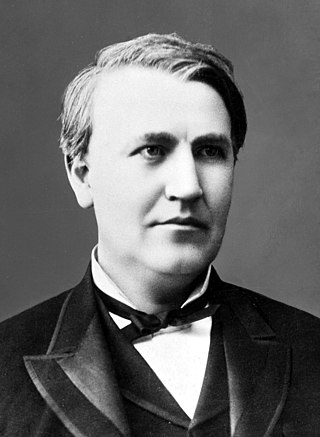
The war of the currents was a series of events surrounding the introduction of competing electric power transmission systems in the late 1880s and early 1890s. It grew out of two lighting systems developed in the late 1870s and early 1880s; arc lamp street lighting running on high-voltage alternating current (AC), and large-scale low-voltage direct current (DC) indoor incandescent lighting being marketed by Thomas Edison's company. In 1886, the Edison system was faced with new competition: an alternating current system initially introduced by George Westinghouse's company that used transformers to step down from a high voltage so AC could be used for indoor lighting. Using high voltage allowed an AC system to transmit power over longer distances from more efficient large central generating stations. As the use of AC spread rapidly with other companies deploying their own systems, the Edison Electric Light Company claimed in early 1888 that high voltages used in an alternating current system were hazardous, and that the design was inferior to, and infringed on the patents behind, their direct current system.

The National Electric Light Association (NELA) was a national United States trade association that included the operators of electric central power generation stations, electrical supply companies, electrical engineers, scientists, educational institutions and interested individuals. Founded in 1885 by George S. Bowen, Franklin S. Terry and Charles A. Brown, it represented the interests of private companies involved in the fledgling electric power industry that included companies like General Electric, Westinghouse and most of the country's electric companies. The NELA played a dominant role in promoting the interests and expansion of the U.S. commercial electric industry. The association's conventions became a major clearinghouse for technical papers covering the entire field of electricity and its development, with a special focus on the components needed for centralized power stations or power plants. In 1895 the association sponsored a conference that led to the issue of the first edition of the U.S. National Electrical Code. Its rapid growth mirrored the development of electricity in the U.S. that included regional and statewide affiliations across the country and Canada. It was the forerunner of the Edison Electric Institute. Its highly aggressive battle against municipal ownership of electric production led to extensive federal hearings between 1928 and 1935 that led to its demise. Its logo is an early depiction of Ohm's law which is "C equals E divided by R," or "the current strength in any circuit is equal to the electromotive force divided by the resistance," or the basic law of electricity. It was established in 1827 by Dr. G. S. Ohm.

Pavel Nikolayevich Yablochkov was a Russian electrical engineer, businessman and the inventor of the Yablochkov candle and the transformer.
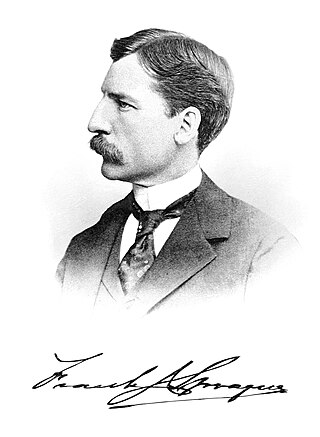
Frank Julian Sprague was an American inventor who contributed to the development of the electric motor, electric railways, and electric elevators. His contributions were especially important in promoting urban development by increasing the size cities could reasonably attain and by allowing greater concentration of business in commercial sections. He became known as the "father of electric traction". Demonstrating an aptitude for science and mathematics, Sprague secured an appointment to the U.S. Naval Academy in 1874 and, after graduation in 1878 and 2 years at sea, resigned to pursue his career in electrical engineering.
The American Institute of Electrical Engineers (AIEE) was a United States-based organization of electrical engineers that existed from 1884 through 1962. On January 1, 1963, it merged with the Institute of Radio Engineers (IRE) to form the Institute of Electrical and Electronics Engineers (IEEE).
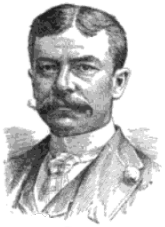
Edward Hibberd Johnson was an inventor and business associate of American inventor Thomas Alva Edison. He was involved in many of Edison's projects, and was a partner in an early organization which evolved into General Electric. When Johnson was Vice President of the Edison Electric Light Company, a predecessor of Con Edison, he created the first known electrically illuminated Christmas tree at his home in New York City in 1882. Edward H. Johnson became the Father of Electric Christmas Tree Lights.

Edwin James Houston was an American author, electrical engineer, academic, businessman, and inventor.
Patrick Bernard Delany was an Irish-American electrician and inventor. Newspaper feature coverage in 1909 called him "the world's greatest telegraph expert and inventor."

Philip H. Diehl was a German-American mechanical engineer and inventor who held several U.S. patents, including electric incandescent lamps, electric motors for sewing machines and other uses, and ceiling fans. Diehl was a contemporary of Thomas Edison and his inventions caused Edison to reduce the price of his incandescent bulb.
Electric power transmission, the tools and means of moving electricity far from where it is generated, date back to the late 19th century. They include the movement of electricity in bulk and the delivery of electricity to individual customers ("distribution"). In the beginning, the two terms were used interchangeably.
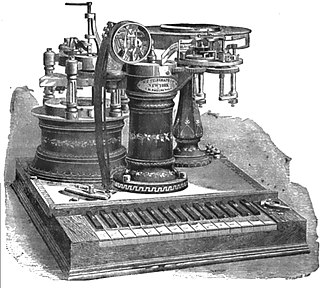
George May Phelps was a 19th-century American inventor of automated telegraphy equipment. He is credited with synthesizing the designs of several existing printers into his line of devices which became the dominant apparatus for automated reception and transmission of telegraph messages.
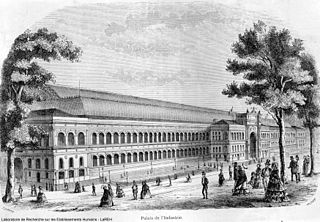
The first International Exposition of Electricity ran from 15 August 1881 through to 15 November 1881 at the Palais de l'Industrie on the Champs-Élysées in Paris, France. It served to display the advances in electrical technology since the small electrical display at the 1878 Universal Exposition. Exhibitors came from the United Kingdom, United States, Germany, Italy and the Netherlands, as well as from France. As part of the exhibition, the first International Congress of Electricians presented numerous scientific and technical papers, including definitions of the standard practical units volt, ohm and ampere.
The Electro-Dynamic Light Company of New York was a lighting and electrical distribution company organized in 1878. The company held the patents for the first practical incandescent electric lamp and electrical distribution system of incandescent electric lighting. They also held a patent for an electric meter to measure the amount of electricity used. The inventions were those of Albon Man and William E. Sawyer. They gave the patent rights to the company, which they had formed with a group of businessmen. It was the first company in the world formally established to provided electric lighting and was the first company organized specifically to manufacture and sell incandescent electric light bulbs.

Sidney Howe Short was an electrical engineer, inventor, physicist, professor and businessman. He is known for the development of electric motors and electric railway equipment. His inventions were so successful that even his competitors dubbed him "The Trolley King". He also developed telephone equipment much like that of Alexander Graham Bell. As a businessman he was president, key engineer, or advisor of different companies related to electrical equipment. It is claimed that he had nearly as many electrical innovations as Thomas Edison.
















